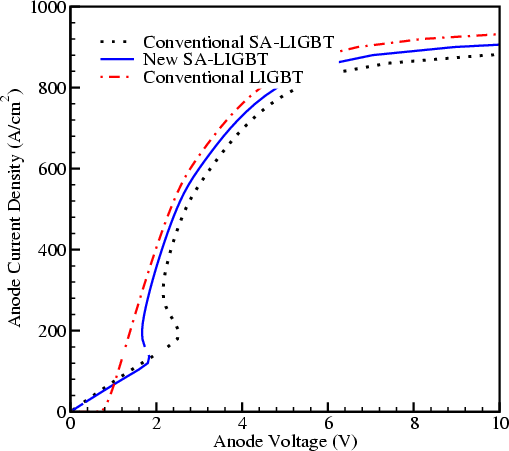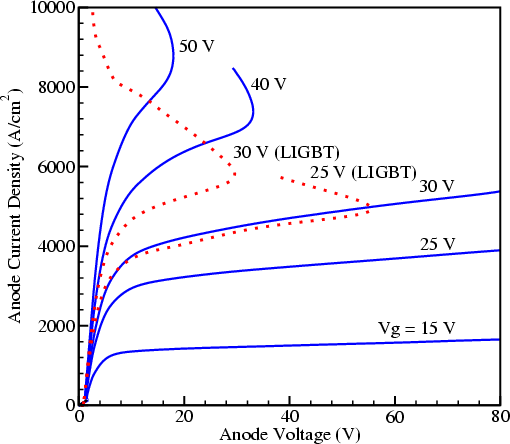
Previous: 4.5.3.1 Forward Blocking Characteristics Up: 4.5.3 Simulation Results Next: 4.5.3.3 Switching Characteristics
The on-state performance of the proposed SA-LIGBT has been simulated and compared with the conventional device. Figure 4.47 shows the comparison of the on-state characteristics of a conventional SOI LIGBT, a conventional SOI SA-LIGBT, and the proposed SOI SA-LIGBT which has a trench oxide at the drain/anode region. As can be seen in the figure, SA-LIGBTs have a NDR region which cannot be found in conventional LIGBTs. This is due to the two different conduction mechanisms responsible for the current flow.
The NDR corresponds to the snap-back regions in the I-V curves
in Figure 4.47. With the proposed structure the snap-back voltage
is reduced effectively compared to the conventional SA-LIGBT which
has a same ![]() -anode length. The snap-back voltage of the proposed
SOI SA-LIGBT is 1.95V which is reduced by about 20% compared to the
conventional SA-LIGBT (about 2.45V) which has the same device parameters.
It shows that the trench oxide at the drain/anode can suppress the NDR
effectively without increasing the
-anode length. The snap-back voltage of the proposed
SOI SA-LIGBT is 1.95V which is reduced by about 20% compared to the
conventional SA-LIGBT (about 2.45V) which has the same device parameters.
It shows that the trench oxide at the drain/anode can suppress the NDR
effectively without increasing the ![]() -anode length.
-anode length.
Figure 4.48 shows the I-V characteristics of the proposed SOI SA-LIGBT.
Because of the weak injection of the ![]() -bipolar structure compared to the
conventional LIGBT, the current density of the proposed SA-LIGBT
is lower than that of the conventional LIGBT.
-bipolar structure compared to the
conventional LIGBT, the current density of the proposed SA-LIGBT
is lower than that of the conventional LIGBT.
 |
 |
However, the forward bias safe operating area (FBSOA) limited by the latch-up parasitic thyristor inherent in its structure is increased compared to the conventional SOI-LIGBT.
I-V curves in the figure
show that the SA-LIGBT has good saturation currents up to
![]()
![]() 30V
and
30V
and
![]()
![]() 80V without latch-up behavior.
80V without latch-up behavior.
Jong-Mun Park 2004-10-28